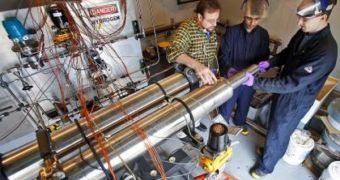One of the main goals in the field of hydrogen car research is the creation of a good fueling system. That is to say, a system that would allow travelers to fill their vehicles' fuel cells in less than 5 minutes, and then drive some 300 miles with a single charge. Making this happen is not as easy as it may seem, because the process usually associated with the refueling emits a lot of heat, which needs to be neutralized, if the amount of time needed to refill the cells is to be kept at reasonable levels.
The current technology consists of a system involving a very fine powder, known as metal hydride. This powder is able to absorb hydrogen very effectively, but, unfortunately, the entire process releases very large amounts of heat. Therefore, having a good cooling system at all refilling terminals is very important.
“The hydride produces an enormous amount of heat. It would take a minimum of 40 minutes to fill the tank without cooling, and that would be entirely impractical,” Purdue University (PU) Professor of Mechanical Engineering Issam Mudawar, who is also the leader of the new research, says.
“The idea is to have a system that fills the tank and at the same time uses accessory connectors that supply coolant to extract the heat. This presented an engineering challenge because we had to figure out how to fill the fuel vessel with hydrogen quickly while also removing the heat efficiently. The problem is, nobody had ever designed this type of heat exchanger before. It's a whole new animal that we designed from scratch,” he adds. Mudawar is also working with Hydrogen Systems Laboratory (HSL) Manager Timothee Pourpoint, who is also a research assistant professor of aeronautics and astronautics.
As a response to these challenges, the team has created a system where the hydride is contained in small “pockets” inside a pressure chamber, where hydrogen is injected at pressure and gets quickly absorbed. “This process is reversible, meaning the hydrogen gas may be released from the metal hydride by decreasing the pressure in the storage vessel. The heat exchanger is fitted inside the hydrogen storage pressure vessel. Due to space constraints, it is essential that the heat exchanger occupy the least volume to maximize room for hydrogen storage,” Mudawar explains.
Basically, the finished cooling system relies on regular automotive coolant, which circulates inside a U-shaped tube, between the pressure chamber and the aluminum heat exchanger. The intricate construction of the exchanger ensures a smooth temperature absorption when the hydrogen hits the metal hydride. “As newer and better metal hydrides are developed by research teams worldwide, the heat exchanger design will provide a ready solution for the automobile industry,” Darsh Kumar, a researcher at General Motors Corp., underlines.

 14 DAY TRIAL //
14 DAY TRIAL //